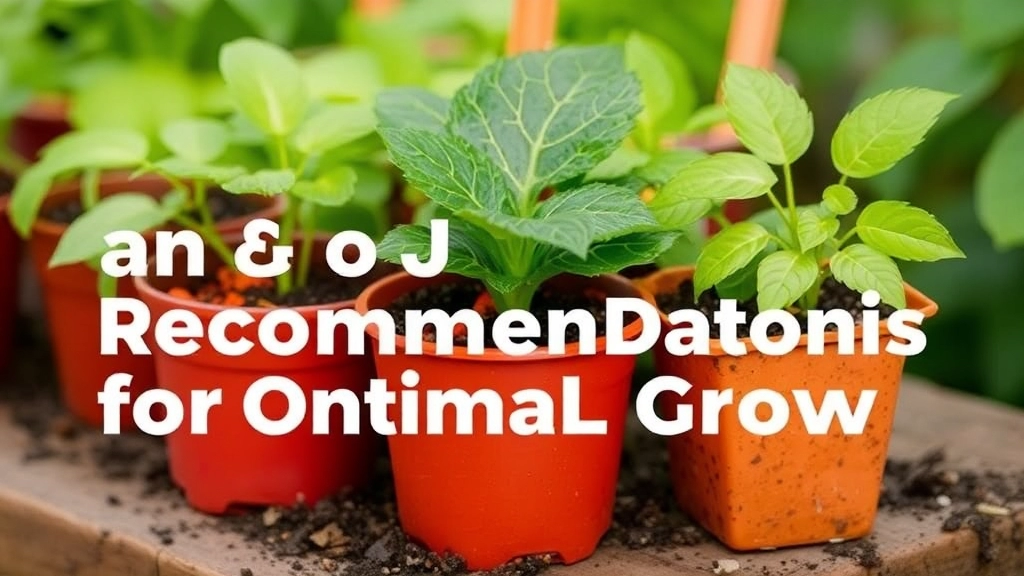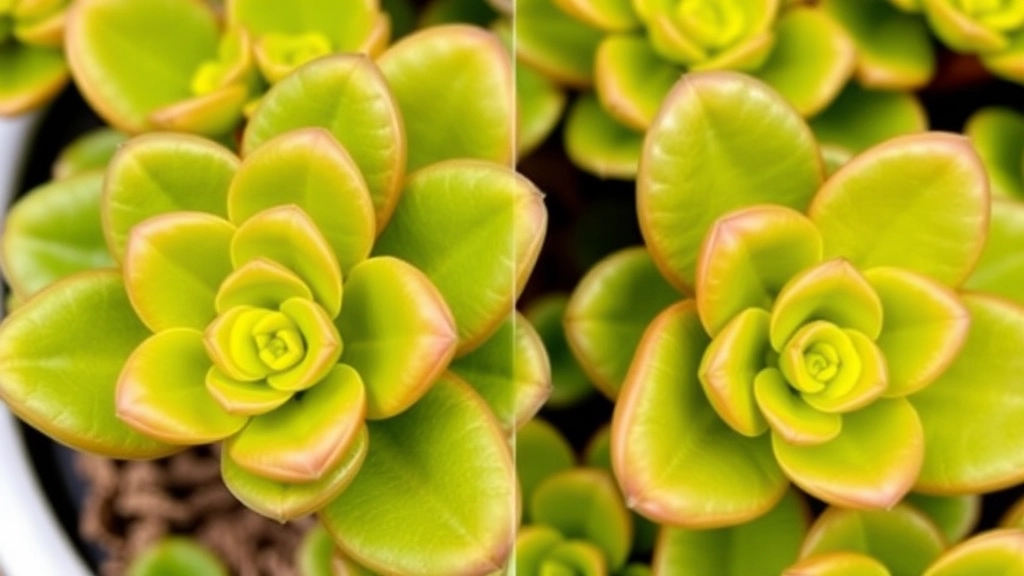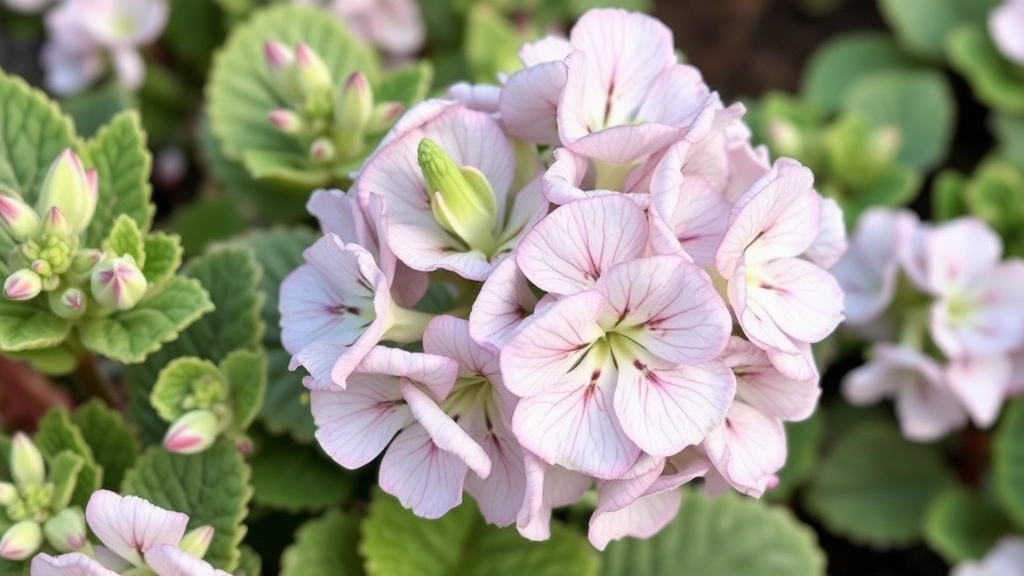Enhance Your Space with Kalanchoe Silver Shadow
Looking to add a touch of elegance to your garden or indoor space? The Kalanchoe Silver Shadow is a stunning succulent known for its silvery, velvety leaves that can elevate any setting. In this guide, I’ll share essential tips on light and watering requirements, ensuring your Silver Shadow thrives in its new home.
Soil and Potting Needs
Understanding the soil and potting needs is crucial for the optimal growth of your Kalanchoe Silver Shadow. I’ll also cover propagation techniques, so you can expand your collection effortlessly.
Styling Your Kalanchoe
Plus, we’ll explore how to style this unique plant both indoors and outdoors, keeping your space fresh and vibrant.
When it comes to nurturing your Kalanchoe Silver Shadow, understanding its light and watering needs is paramount. You might be wondering, “How much light does this plant really need?” or “Am I overwatering my Kalanchoe?” These are common concerns among plant enthusiasts.
### Light Requirements
Kalanchoe Silver Shadow thrives in bright, indirect sunlight. Here are some key points to consider:
– **Optimal Light**: Aim for 6 hours of indirect sunlight daily.
– **Avoid Direct Sun**: Too much direct sunlight can scorch the leaves.
– **Indoor Placement**: A south or west-facing window works wonders.
– **Signs of Insufficient Light**: If your plant becomes leggy or its leaves start to drop, it may need more light.
For more detailed information on light requirements, you can refer to our comprehensive [outdoor kalanchoe care guide](https://planthq.org/outdoor-kalanchoe-care-expert-tips-and-best-practices/).
### Watering Guidelines
Watering is a critical aspect of Kalanchoe care. Overwatering is a common mistake that can lead to root rot. Here’s how to get it right:
– **Drench and Dry**: Water the plant thoroughly, allowing the soil to dry out completely between waterings.
– **Frequency**: Typically, every 2-3 weeks is sufficient, but adjust based on your climate.
– **Seasonal Changes**: During the growing season (spring and summer), increase watering frequency; in winter, reduce it.
For additional tips on watering and overall plant health, check out our [complete guide to Kalanchoe plant care](https://planthq.org/complete-guide-to-kalanchoe-plant-care/).
Soil and Potting Recommendations for Optimal Growth

So, you’ve got your Kalanchoe Silver Shadow, and now you’re probably wondering, “What kind of soil does it need?”
Well, let’s break it down.
Choosing the Right Soil
Kalanchoes thrive in well-draining soil. Here’s what to look for:
- Cactus or Succulent Mix: This is a go-to option. It’s designed to drain quickly and prevents water from sitting around the roots.
- DIY Mix: If you’re feeling crafty, mix regular potting soil with sand or perlite. Aim for a 2:1 ratio of potting soil to sand/perlite. This combo keeps things airy for those roots.
Pot Selection
Now, let’s chat about pots.
- Drainage Holes: Always pick a pot with drainage holes. This is crucial to avoid root rot.
- Size Matters: Choose a pot that’s just a bit larger than the root ball. Too big, and you risk overwatering. Too small, and your plant won’t have enough room to grow.
Repotting Tips
If your Kalanchoe starts to outgrow its pot, it’s time to repot. Here’s how:
- Timing: Spring is the best time to repot. The plant is waking up from dormancy and ready to grow.
- Gently Remove: Carefully take the plant out of its old pot. Loosen the roots if they’re tightly bound.
- Fresh Soil: Place it in new soil, ensuring the top of the root ball is level with the soil surface.
Fertilising
While Kalanchoe doesn’t need much food, a little fertiliser can help:
- Frequency: Feed it every 4-6 weeks during the growing season (spring and summer) with a diluted cactus fertiliser.
- Skip Winter: It’s best to hold off on fertilising during the winter months when growth slows down.
How to Propagate Kalanchoe Silver Shadow: A Step-by-Step Guide
Are you looking to expand your collection of Kalanchoe Silver Shadow? Propagation is a rewarding way to do this, and it’s simpler than you might think. Let’s dive into the step-by-step process to help you successfully propagate this stunning succulent.
Step 1: Choose Your Method
There are two popular methods for propagating Kalanchoe Silver Shadow: leaf cuttings and offsets.
- Leaf Cuttings: This method involves taking a healthy leaf and allowing it to root.
- Offsets: If your Kalanchoe has produced offsets (small plants at the base), these can be removed and replanted.
Step 2: Gather Your Supplies
Before you begin, gather the following items:
- Sharp, clean scissors or a knife
- A small pot with drainage holes
- Well-draining soil mix (preferably cactus soil)
- A container for water (if using leaf cuttings)
- A sunny spot for the cuttings to root
Step 3: Take Cuttings
- For Leaf Cuttings:
- Select a healthy leaf from the parent plant.
- Carefully cut the leaf at the base using your scissors.
- Allow the cut leaf to dry for a few hours to form a callous.
- For Offsets:
- Gently twist or cut the offset away from the parent plant.
- Ensure it has some roots attached for better success.
Step 4: Planting
- Leaf Cuttings:
- Place the calloused leaf on top of the soil in the pot.
- Do not bury it; it should rest on the surface.
- Offsets:
- Plant the offset into the soil, ensuring the roots are covered.
Step 5: Watering
- For both methods, wait about a week before watering to allow roots to develop.
- After that, lightly mist the soil to keep it moist but not soggy.
Step 6: Provide Proper Conditions
- Place your pot in a bright, indirect light location.
- Maintain a warm environment, ideally between 20°C to 25°C (68°F to 77°F).
Step 7: Monitor Growth
- In a few weeks, you should start to see new growth.
- Once the roots are well established, you can treat your new plants like mature Kalanchoe Silver Shadow.
For more detailed care instructions, you might find our Ultimate Guide to Kalanchoe Silver Dollar Care and Propagation useful. Additionally, if you’re looking to purchase more Kalanchoe varieties, check out our guide to buying flowering Kalanchoe plants online.
Preventing Common Issues: Pests, Diseases, and Root Rot

As we delve deeper into caring for Kalanchoe Silver Shadow, it’s crucial to address potential problems that can hinder its growth.
Common Pests
Kalanchoe Silver Shadow is generally resilient, but it can fall victim to pests such as:
- Aphids: Tiny, sap-sucking insects that can distort leaves.
- Mealybugs: White, cottony pests that often hide in leaf crevices.
- Spider Mites: Microscopic pests that thrive in dry conditions, causing speckled leaves.
Prevention Tips:
- Regularly inspect your plant for any signs of infestation.
- Use insecticidal soap or neem oil for treatment.
- Keep your plant in a well-ventilated area to deter pests.
Diseases
While Kalanchoe Silver Shadow is hardy, it can be susceptible to diseases like:
- Powdery Mildew: A fungal disease that appears as a white powder on leaves.
- Leaf Spot: Caused by various pathogens, leading to discolored spots on leaves.
Prevention Tips:
- Ensure proper air circulation around the plant.
- Avoid overhead watering to keep leaves dry.
- Remove any infected leaves promptly to prevent spread.
Root Rot
One of the most common issues faced by Kalanchoe Silver Shadow is root rot, primarily caused by overwatering.
Signs of Root Rot:
- Wilting despite adequate watering.
- Yellowing leaves.
- A foul smell from the soil.
Prevention Tips:
- Use well-draining soil and pots with drainage holes.
- Water only when the top inch of soil is dry.
- Consider using a moisture meter to avoid overwatering.
When it comes to incorporating Kalanchoe Silver Shadow into your home or garden, you might wonder how to showcase its unique beauty effectively. This stunning succulent, with its striking silver foliage, can enhance various spaces, both indoors and outdoors.
### Indoor Styling Ideas
– **Bright Windowsills**: Place your Kalanchoe Silver Shadow on a sunny windowsill. The bright light will not only keep it healthy but also create a beautiful focal point in your living space.
– **Minimalist Shelves**: Use simple, modern shelves to display your plant. Pair it with other succulents or decorative items for an eye-catching arrangement.
– **Hanging Planters**: Consider using hanging planters. This adds dimension to your indoor space while allowing the trailing leaves to create a lovely cascade.
– **Terrariums**: For a unique touch, place your Kalanchoe in a terrarium. Combine it with stones and other small succulents to create a miniature garden.
### Outdoor Styling Ideas
– **Patio Display**: Position your Kalanchoe Silver Shadow on your patio or balcony. It thrives in bright light and can add a touch of elegance to outdoor gatherings.
– **Rock Gardens**: Incorporate it into a rock garden. The contrast between the silver leaves and natural stones creates a stunning visual appeal.
– **Border Planting**: Use it as a border plant in your garden beds. Its low-growing nature makes it perfect for framing pathways or flower beds.
– **Mixed Planters**: Create a mixed planter with other drought-tolerant plants. This not only enhances the aesthetic but also ensures that all plants have similar care requirements.
For more tips on how to care for your Kalanchoe, check out this [ultimate guide](https://planthq.org/how-to-care-for-kalanchoe-succulent-ultimate-guide/). If you’re interested in propagating different varieties, our [step-by-step propagation guide](https://planthq.org/kalanchoe-daigremontiana-propagation-guide-stepbystep-tips/) can be very helpful.
Pet Safety and Toxicity Considerations for Kalanchoe Beharensis

So, you’ve got your beautiful Kalanchoe Silver Shadow, and you’re wondering how it fits into your pet-friendly home.
First off, it’s crucial to know that Kalanchoe Beharensis, like many succulents, can be toxic to pets, especially cats and dogs.
Here’s what you need to keep in mind:
- Toxicity Level: Kalanchoe contains compounds called bufadienolides. These can cause symptoms like vomiting, diarrhea, and, in severe cases, heart issues in pets.
- Signs of Toxicity: If your furry friend gets into your plant, watch out for:
- Vomiting
- Lethargy
- Diarrhea
- Abnormal heart rhythms
- Immediate Action: If you suspect your pet has nibbled on your Kalanchoe, contact your vet right away. They can guide you on the best course of action.
Pet-Safe Alternatives
If you’re worried about your pets getting too close to your Kalanchoe, consider these options:
- Placement: Keep your plant out of reach, perhaps on a high shelf or in a room your pets don’t access.
- Pet-Friendly Plants: Look into alternatives like spider plants or Boston ferns, which are safe for pets and still add a touch of greenery to your space.
Seasonal Care Tips: Managing Growth Across Different Climates
As we transition from one season to another, it’s crucial to adapt our care for Kalanchoe Silver Shadow. This resilient plant thrives under various conditions, but understanding its seasonal needs can make a world of difference in its growth and health.
Spring: Awakening Growth
During spring, Kalanchoe Silver Shadow begins its active growth phase. Here’s how to support it:
- Light: Increase exposure to bright, indirect sunlight.
- Watering: Water more frequently as the soil dries out faster.
- Fertilizing: Introduce a balanced liquid fertilizer every 4-6 weeks.
Summer: Thriving Heat
In summer, your Kalanchoe may need extra attention due to higher temperatures:
- Light: Ensure it receives plenty of sunlight but avoid harsh afternoon rays.
- Watering: Maintain a consistent watering schedule, allowing the top inch of soil to dry out between waterings.
- Humidity: If indoors, consider using a humidifier or placing a tray of water nearby.
Autumn: Preparing for Dormancy
As autumn arrives, it’s time to prepare your plant for the cooler months:
- Light: Gradually reduce direct sunlight exposure.
- Watering: Cut back on watering as growth slows down.
- Fertilizing: Stop fertilizing by late autumn to allow the plant to rest.
Winter: Dormant Period
In winter, Kalanchoe Silver Shadow enters dormancy, requiring minimal care:
- Light: Provide bright, indirect light to prevent leggy growth.
- Watering: Water sparingly; ensure the soil is completely dry before the next watering.
- Temperature: Keep it in a warm spot, away from drafts.
For more detailed guidance on Kalanchoe care, you can check out our Kalanchoe Copper Spoons Care Guide and our Complete Guide to Kalanchoe Pinnata Air Plant Care.
FAQs About Kalanchoe Silver Shadow
What type of soil is best for Kalanchoe Silver Shadow?
Kalanchoe Silver Shadow thrives in well-draining soil. A cactus or succulent mix is ideal, or you can create a DIY mix by combining regular potting soil with sand or perlite in a 2:1 ratio.
What kind of pot should I use for Kalanchoe Silver Shadow?
Choose a pot with drainage holes to prevent root rot. The pot should be slightly larger than the root ball to provide enough room for growth without risking overwatering.
How often should I repot my Kalanchoe Silver Shadow?
Repot your Kalanchoe Silver Shadow in the spring when it begins to outgrow its current pot. This is the best time as the plant is coming out of dormancy and ready to grow.
What is the recommended fertilizing schedule for Kalanchoe Silver Shadow?
Feed your Kalanchoe every 4-6 weeks during the growing season (spring and summer) with a diluted cactus fertilizer. Avoid fertilizing during the winter months when growth slows down.
What pests should I watch out for on my Kalanchoe Silver Shadow?
Common pests include aphids, mealybugs, and spider mites. Regularly inspect your plant and use insecticidal soap or neem oil for treatment. Keeping your plant in a well-ventilated area can also help deter pests.
What diseases can affect Kalanchoe Silver Shadow?
Kalanchoe Silver Shadow can be susceptible to powdery mildew and leaf spot. Ensure proper air circulation, avoid overhead watering, and promptly remove any infected leaves to prevent disease spread.
How can I prevent root rot in Kalanchoe Silver Shadow?
Use well-draining soil and pots with drainage holes. Water only when the top inch of soil is dry, and consider using a moisture meter to avoid overwatering. Signs of root rot include wilting, yellowing leaves, and a foul smell from the soil.
Is Kalanchoe Silver Shadow toxic to pets?
Yes, Kalanchoe Beharensis, including the Silver Shadow variety, can be toxic to pets. It contains bufadienolides, which can cause vomiting, diarrhea, and heart issues in pets. If you suspect your pet has ingested any part of the plant, contact your vet immediately.
What are some pet-safe alternatives to Kalanchoe Silver Shadow?
If you’re concerned about pet safety, consider placing your Kalanchoe out of reach or opting for pet-friendly plants like spider plants or Boston ferns.
References
-
How to grow Kalanchoe
-
Kalanchoe Plant Profile
-
Kalanchoe Toxicity
